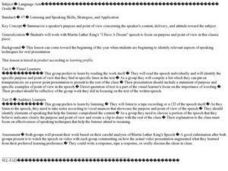National Endowment for the Humanities
Kate Chopin's The Awakening: Local Color in the Late 19th Century
Kate Chopin's The Awakening introduces readers not only to the lush Louisiana setting of Grand isle but also to the nuances of Creole culture. the second lesson in a three-part series examines how Chopin's use of literary realism and...
Curated OER
Even
Delve into the more nuanced parts of grammar with this ESL worksheet. Students work with the word "even" in ten different questions, which provide sentences in different contexts. They choose whether or not to use the word, and in what...
Curated OER
A Nice Story
Explore word choice in writing. Your class listens to a short story entitled "A Nice Day" (included) and discusses how the story could be improved. Pupils replace the word nice throughout the story with various synonyms, then reread the...
Curated OER
Know Before You Go: Anticipating and Previewing Difficult Texts such as The Bluest Eye
Support your scholars with these anticipatory questions to go along with The Bluest Eye by Toni Morrison. The objective, rationale, and teacher instructions are clearly explained, followed by an anticipation guide for pages 81-93 and the...
Curated OER
Literature and Humor
From Canterbury Tales to The Odd Couple, this presentation details the different treatments of humor in different literary formats. Numerous authors and works of literature are represented here as examples of satire, irony, comedy, and...
Curated OER
The Pillsbury Doughboy
Mourning the death of the Pillsbury Doughboy (from a yeast infection and pokes in the belly), this presentation discusses the use of puns, metaphors, and polysemes. The slide show continues by discussing other popular metaphors and...
Curated OER
Introduction to Legal Citation
A good resource for law students who need some help with citation, this presentation covers many key points from the ALWD Citation Manual. The nuances of legal citation, such as typeface, numbers, and primary sources, will become...
Curated OER
Punctuation 2: Other than Commas
Thoroughly cover the nuances of apostrophes, quotation marks, dashes, hyphens, colons, and semi-colons. Intended for higher-level English classes, the examples given pertain to tricky rules and formal language. There are no animations or...
Curated OER
Grammar Practice: Choosing Between Fewer and Less
When should you use "fewer" instead of "less?" Reinforce this grammatical nuance in your class with this handy reference sheet. A short explanation guides students through the process of choosing one word over the other, and a series of...
Read Theory
Analogies 2 (Level 8)
Examine nuances in word meanings with an exercise based around word analogies. Learners use the sentences and frames provided to help them determine the relationships between words. They complete 10 analogies.
English Grammar
Gerund or Infinitive – Fill in the Correct Form
Middle schoolers love listening to music, and they also love to listen to music. So what's the difference? Spell out the nuanced ways to use gerunds and infinitives with a 50-question grammar exercise. Given short sentences and verbs,...
University of North Carolina
Transitions (ESL)
When it comes to comparing and contrasting in an essay, looking at a chart and picking a random transition word may not do the trick. As explained in an informational writing handout, the words writers use to move from one idea to...
Curated OER
Close Reading
Eleventh graders read and study Hamlet. Then they are introduced to close reading as a means of understanding what is being read--not only understanding the printed word, but also the nuances and connotations of language as it is used by...
Curated OER
Analyzing Poetry with TPCASTT
Middle schoolers read a poem and complete a TPCASTT chart. They make a prediction about the title (T) , paraphrase each line (P), identify poetic devices and nuances (C-connotation), explore mood and tone (A-attitude), point out shifts...
Curated OER
Martin Luther King's "I Have a Dream"
Dr. Martin Luther King's "I Have a Dream" speech provides the text for a study of how to analyze a speaker’s content, delivery and attitude. Visual learners identify specific lines that reveal King’s purpose and point of view while...
Curated OER
A Gesture Is Worth a Thousand Words
Students share observations on the nuances of meaning in face to face and online interactions with others. After reading an article, they identify the causes and effects of internet flaming. They create their own comic strips...
Curated OER
Effective Literary Analyses
Twelfth graders discuss a fictional text that they are given, they identify passages, which highlight the author's style, language naances and textual ambiguities. Pupils brainstorm possible topics for an analytical essay, they are...
Curated OER
Worksheet 8: Reading: A Job Problem
This learning exercise is an appropriate way to have adults learning English review the nuances of the vocabulary. Students have to read an email about a work-related scenario and answer 12 questions.
Curated OER
Interpreting Dramatic Works
Action! Delve into character development in the play Fences by August Wilson, setting the stage for learners to analyze character nuances. Thespians choose a scene from the script, responding with a written account of the...
Curated OER
Shakespeare Film Clip Assignment Worksheet
In this Shakespeare Film Clip worksheet, students list main ideas in the play, important images and motifs, and chose at least six main scenes or quotes that relate to the theme. Students then discuss what is complex or...
E Reading Worksheets
Tone: Voice of the Speaker
Tone and mood are easy to use interchangeably—and yet they are very different elements of literature. Help middle schoolers discern between the way a speaker feels about his or her subject and the way the audience is meant to feel with a...
Pearson
Subject and Object Pronouns; Direct and Indirect Object
Replacing a gift can end up in an awkward moment—but not when replacing a noun with a pronoun! Watch the most effective ways to use subject and object pronouns, as well as direct and indirect object pronouns, with an entertaining...
Pearson
Advice: Should, Shouldn't, Ought to, Had Better, and Had Better Not
You shouldn't miss out on an opportunity to review should, shouldn't, ought to, had better, and had better not! Elementary and middle schoolers view a slideshow presentation that focuses on usage rules and examples for...
K12 Reader
Order of Adjectives: Circle the Correct One
Which comes first in an adjective phrase: a word denoting a noun's quality, or a word describing a noun's function? If your elementary grammarians don't know the answer, have them review ten pairs of adjective phrases and circle the one...

























